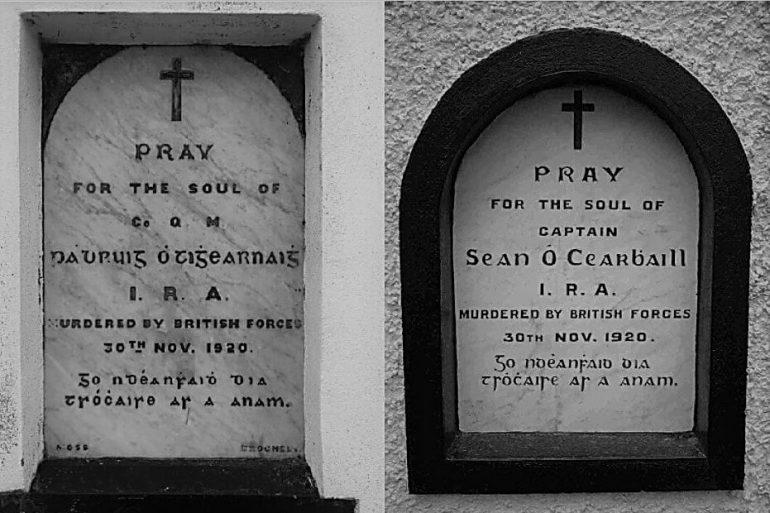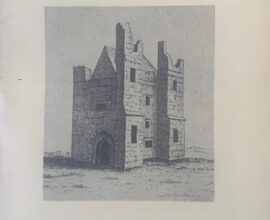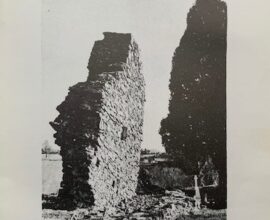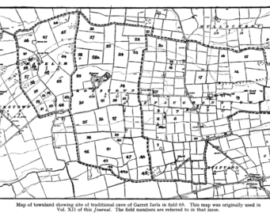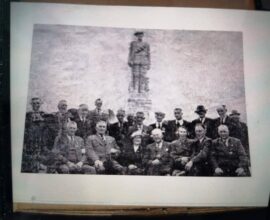Erection of Memorial Statue, Sept 1955 (Part 1)
Since the mid -1950s, on the last Sunday in November, a large crowd, accompanied by a Colour Party, gathers at the memorial statue to honour and commemorate Sean O’Carroll and Patrick Tierney, who were murdered in Ardee by Crown Forces on the night of the 30th November 1920. Initially the Colour Party was accompanied by a Firing Party who conducted a gun salute for the two murdered men.
The monument itself was initially unveiled with great ceremony in September 1955 when it was originally erected opposite the old church of Saint Johns in John Street and was later moved to its present position on the Drogheda Road beside the boys National School, to facilitate the building of the new church. The statue commemorated the memory of Captain Sean O’Carroll and Quarter Master Patrick Tierney who, on the night of 30th November 1920, were taken out of their houses and shot by Crown Forces who had been stationed in Gormanstown Camp.
O’ Carroll was a native of Kildare and came to Ardee to teach Irish for the Gaelic League. He lodged in the Lynch family home in Castle Street. Patrick Tierney was a native to the town and he lived with his parents and siblings in what was then called Tisdale Street (now called Tierney Street in his honour). The unveiling event was drew huge crowds with people from all parts of Ireland in attendance. Special Buses were also commissioned to take the many people from Belfast who were present that September morning. Sean O’Carroll had moved to Belfast from his native Kildare a few years earlier, where he became very active in the Volunteer movement.
The Parade
The events of that day, as reported in the press, commenced with a large parade that begun at the Fair Green. The parade was led up through the town by the Ardee Brass and Reed Band and the Colours were carried by Daniel McCarthy who was flanked by members of the Dundalk Old IRA who provided the colour and the firing party for the salute that day.
There was great pomp and ceremony around the statue that day and, when the parade reached it, an unveiling ceremony was performed followed by a decade of the rosary. The Old IRA Firing Party then discharged their gun salute for the two fallen men. This was followed by the band playing ‘A Nation Once Again’ and such was the ferocity of the singing from the assembled crowds that it must have been heard for miles around.

Proclamation of Independence
Mr Patrick Kearney, from Dundalk, then read the Proclamation of the Irish Republic. His presence was poignant that day because he, himself, was in Ardee that faithful November night in 1920 and was the third intended target of the Crown Forces who had come to his home in search of him that evening. Before closing the proceedings, the Master of Ceremonies that day, remarked that Patrick Kearney ‘did not oblige the Black and Tans by being in the evening that Sean O’Carroll and Patsy Tierney were taken out and shot. Otherwise, his name, no doubt, would have also been inscribed on the memorial’.
The Colour Party, along with the gun salute were continued at each Anniversary for many a year thereafter when the people of Ardee gathered to remember the two murdered men. I can recall from my childhood eagerly awaiting the volley of shots where children, myself included, scrambled to pick up the expended shells that had been discharged from the rifles of the Firing Party.
30 November 1920
Who were these men and why are they been so honoured each year? To get a better understanding of this let me bring you back in time to Ardee on the early morning of the 30th November 1920. On that night the 25 year old O’Carroll was taking out of his lodgings in Castle Street and brought around the corner where he was brutally shot. Whereas he had come to Ardee to teach the Irish Language he was also the Officer Commanding D Company of the Belfast Battalion. Minutes later the 26 year old Patrick Tierney was taken out of his parent’s house in Tisdale Street and was killed in an even more brutal manner.
We are fortunate that the events that unfolded that night can be recalled by statements given by eye witnesses, shortly thereafter, and another account that was left to us when, in 1991, aged over 90, Delia Spillane, Patrick Tierney’s sister, recorded the events that unfolded that night. I will let them speak from the past to continue the story of what happened on the streets of Ardee on 30th November 1920.
A Military Court of Enquiry (I use that term loosely), was quickly convened in Ardee Castle and was actually held the same day that the two men had been shot. Their remit was to enquire ‘into the circumstances under which Patrick Tierney and John O’Carroll, both of Ardee, met their deaths on the morning of the 30th November at Ardee’.
The Inquiry
A Mr Hamill, solicitor for the Tierney family, rose to address the inquiry but the President of the Court, Major R.J.R .Waller from the Battalion HQ in Belfast, instructed that the inquiry was to be held in camera and ordered the courtroom to be cleared. After much protestation the court was eventually cleared including Mr Hamill who, even though he was there to represent the families, was escorted outside the Courthouse by the local Royal Irish Constabulary.
Major Waller, assisted by Lieutenant D. H. Black of the Fifteenth Hussars and Lieutenant R.M. Carr of the Thirty Sixth Battery Division called their first witness, Dr Patrick Joseph Steen from Ardee who had attended to the men that night. The following statements are taking from the minutes of that Court which are preserved in the Military Archives in Kew, Courts of Inquiry in lieu of inquest, WO35.160.0.356-360.
Dr Steen’s Testimony
Dr Steen deposed that; ‘In consequence of what I was told, I went into Station Street, Ardee and there found, about 02.00 hours 30.11.20, a wounded man, John O’Carroll, lying in the street called Station Street, and Father Dolan was with him. I then carried O’Carroll, with the assistance of others, into my house. He was in such a state of collapse that I did not examine him until after his death which took place about 04.30 hours 30.11.20. The deceased had one bullet wound on the side of his chest about the fifth rib which I took to be an entrance wound, and the exit wound of that bullet was between the ninth and tenth rib two and a half inches from the spinal column. A second bullet must have entered just above the middle point of his right collar bone and the exit of that wound was just in the middle of his left shoulder blade. He had a third bullet wound through his right wrist. He died of shock and haemorrhage from the first two bullet wounds. I produce two bullets which fell out of the deceased’s clothes when he was been undressed after death. These two bullets could have caused the wounds in the body of the deceased and death could have been caused by them’.
Dr Steen continued; ‘about 14.00 hours today (the 30.11.20) I viewed the body of Patrick Tierney which was in his father’s house in Tisdale Street, Ardee. On removing the bandages from his head I found practically the whole of the left half of his cranium blown away, and the brain removed and numerous fractures in the remainder of his skull. His lower jaw was fractured on both sides and he had an entrance and exit wounds on the back of the left forearm and the radius was broken. He had an entrance wound at one inch to the left of his spinal column between the 10th and 11th ribs. This wound must have been caused by a bullet which came out producing a hole about the size of a crown piece just below the tip of his breast bone in the abdomen. He had another wound in the left hiltrck an inch from the middle line. Death in this case was caused by shock and haemorrhage caused by gunshot wounds’.
